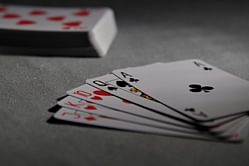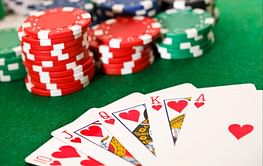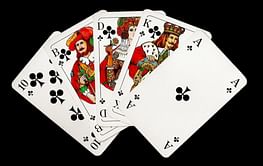Like all games, poker comes with a set of rules that make up the game. Now the rules may differ slightly with the variants, but essentially, they are all based on the same fundamentals. There is a defined set of winning hands, a mandatory blinds bet for every player whether he/she wants to play the hand or not, and the like.
Let’s start with the very basic, like the pack of cards used to play poker, and then make our way up with hand rankings, betting procedure, etc.
The Basics of Poker - Rules for Beginners
The Pack
Poker is always played with a standard 52-card deck. This comes with 4 suits - Hearts, Spades, Diamonds and Clubs - and cards are ranked from 1 (Ace) to King (13 cards in each suit). Some variants of poker have wild cards, which can be cards of a particular type (threes or Kings) or a particular suit. Sometimes, Jokers can be used.
The Poker Hand Ranking
There is a sequence of 10 winning hands for any poker game. The winning hand is always decided taking the 5 highest cards or 5 card sequence into consideration.
Let’s start with the lowest -
i. High card - This is where the player has not made any pair of his/her cards with the cards on the board. Here, the person with the highest card wins.
ii. One pair - In this hand, either two cards on the board, or one card on the board and one in the hole (player’s cards), or both hole cards make a pair.
iii. Two pair - Two different cards are paired in this hand. For example, you have a 3 and 5, and the board also brings a 3 and 5.
iv. Three of a kind - Also known as ‘trips’, in this hand, the player gets 3 cards of the same value. For example, you have a K and 9, and the board brings 2 more 9’s.
v. Straight - In this hand, the player makes a sequence 5 of cards. For example, 3,4,5,6,7 is a straight. A person with a higher straight always wins.
vi. Flush - Here, the player gets 5 cards of the same suit, but not in a sequence. For example, you have 3 and 7 of Hearts, and the board has 9,2, and Q of Hearts, then you have a flush. If all cards on the board are of the same suit, the person with the highest card wins.
vii. Full house - In this hand, the player has a pair of one card and trips of the other. For example, you have 8,K and the board is 4,8,K,9,K; here, you have a full house of K,K,K,8,8.
viii. Four of a kind - This hand is also called ‘quads’. Here, you get all 4 cards of the same value. For example, 4 Kings.
ix. Straight flush - This hand is a combination of the straight and flush. For example, you have a straight flush if you get 3,4,5,6,7 ALL of the same suit.
x. Royal flush - This is the biggest, and rarest, hand in all of poker. The royal flush is when you get 10, J, Q, K, Ace - ALL of the same suit.
How Betting Works
For every game, there is a pre-decided blinds structure. Tables can be of 50 cents/$1 blinds or $10k/$20k blinds - pretty much any amount. The dealer changes with every hand - the player next to the dealer becomes the dealer for the next hand.
The person next to the dealer puts in the small blind, and the person after that puts in the big blind. No one can bet an amount below the big blind in the first round. Here are some terms of betting -
Bet - Betting an amount when no one else on the table has.
Call - Matching the amount another player has bet.
Raise - Calling the bet and then raising the amount further.
Fold - Exiting the current hand by laying your cards face down.
Check - After the first round of betting, players can simply check and not bet, moving on to the next player. However, after one player bets, others can only call, raise or fold.
Types of Games
Limit games
In these games, you can bet only a set amount. For example, for a $5/$10 game, you can bet only in additions of $5 before and on the flop, and additions of $10 after the flop. If A bets $5 on the flop, B can only bet $10, not higher. C can bet $15.
No-limit games
These games have no betting limit. The minimum bet is usually the same as the big blind, and the max bet is betting the entire stack.
Pot limit games
Pot limit games follow the same format as no-limit games; the only difference is that the maximum bet a player can make is same as the amount already in the pot.
Ring games
These are cash games where players buy in and play with each other. Players can leave a table or game and return subject to some house rules.
Single Table Tournaments
STT’s are poker games where players buy into the game and play until one player remains. These games take place on only one table with specific number of players.
Multi-table Tournaments
MTT’s are like knockout games. Many players buy into the games, which run on various tables. The number of tables reduces as players leave, until the final table remains. The player who wins all the chips wins the tournament.
In Conclusion
There are some unsaid rules about poker as well. For example, it is unethical to win a big hand and then leave the table. It isn’t illegal, but is frowned upon as it does not give other players a chance to win their money back. Similarly, leaving a table and then returning with fewer chips than when you left is also considered bad etiquette, because it infers that you lost, and came to this table to make up for it.
The rules of poker are simple and straightforward, and yet this game is a science and an art. Once you get into the groove, you’ll be able to play both with your ‘brain’ and your ‘mind’.









